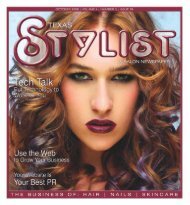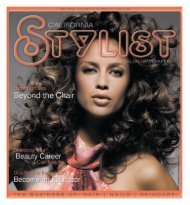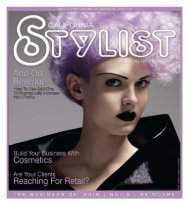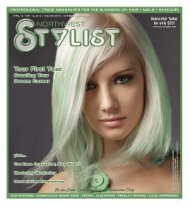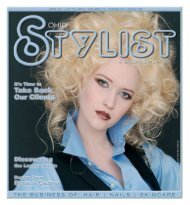Thinning Hair - Stylist and Salon Newspapers
Thinning Hair - Stylist and Salon Newspapers
Thinning Hair - Stylist and Salon Newspapers
You also want an ePaper? Increase the reach of your titles
YUMPU automatically turns print PDFs into web optimized ePapers that Google loves.
How to Care for Curly <strong>Hair</strong><br />
By Michelle Laxson <strong>and</strong> Rebekah Vigil<br />
The popularity of straightening treatments<br />
is on the rise, which is likely due to<br />
the unfair reputation curly hair has for being<br />
unmanageable.<br />
We encourage stylists <strong>and</strong> naturally curly<br />
clients to embrace curl, because when you are<br />
armed with the proper care, cutting <strong>and</strong> styling<br />
techniques, those spirals will inspire envy<br />
in their straight-haired counterparts.<br />
CARE – Curly hair is often drier than<br />
straight hair because of the increased amount<br />
of protein in the hair. Even products that help<br />
increase moisture in the hair often dissipate<br />
<strong>and</strong> disappear quickly. Always apply leave-in<br />
conditioning products to curly hair when it is<br />
very wet, almost dripping, immediately after<br />
shampooing <strong>and</strong> conditioning.<br />
<strong>Hair</strong> will soak in the product more effectively,<br />
because the drier hair is, the quicker the<br />
product will evaporate. A leave-in moisturizing<br />
conditioner will also help define the curls<br />
<strong>and</strong> decrease frizz <strong>and</strong> fluff. After applying a<br />
leave-in conditioner, remember not to dry the<br />
hair by wrapping it in a towel. Using a terry<br />
cloth towel to dry the hair will create frizz,<br />
because the hair follicles are open when the<br />
hair is wet <strong>and</strong> they will grab onto the cloth<br />
particles. Instead, flip upside down <strong>and</strong> comb<br />
through the hair using your fingers.<br />
When drying the hair with your fingers,<br />
try not to alter the shape of the curls. Use<br />
loose h<strong>and</strong>s <strong>and</strong> loose pulling motions so you<br />
do not pull the hair straight. Your goal is to<br />
keep the hair in a natural formation so the hair<br />
retains the shape of the curl. In addition, we<br />
recommend having your clients sleep on silk<br />
pillows rather than cotton. Cotton pillows will<br />
create frizz in the hair, while silk material does<br />
not attach to the curl <strong>and</strong> will help prevent it.<br />
CUTTING – Cutting curly hair is<br />
always more of a challenge because you have<br />
to consider the texture of the hair <strong>and</strong> how<br />
it rounds out, rather than just the shape you<br />
want to achieve. When trying to create a shape<br />
in curly hair, you need to have a cut inside a<br />
cut. The cut needs to have two structures, the<br />
exterior <strong>and</strong> the interior. The cuts can mirror<br />
each other or be opposites, depending on what<br />
you are trying to enhance <strong>and</strong> achieve. The cut<br />
needs to have a disconnection to break up the<br />
roundness, preventing the hair from turning<br />
into a ball. Start with the exterior shape first,<br />
<strong>and</strong> then move to the interior.<br />
STYLING – Knowing how to style curly<br />
hair properly is often the biggest challenge.<br />
After combing the hair, make sure to re-wet<br />
it because if you have combed the hair a lot,<br />
the curls will get stringy during the drying<br />
process. By re-wetting the hair, you will help<br />
eradicate any parting or comb lines in the<br />
memory of the hair.<br />
Apply curl defining products in layers, <strong>and</strong><br />
work in sections so you get the full benefit of<br />
the product. As you diffuse, make sure you<br />
are squeezing hair in tight fists, which forces<br />
product into the hair. Always keep the diffuser<br />
on low heat <strong>and</strong> low air because higher heat<br />
makes the hair look frizzy. This may take<br />
longer, but the end result will be worth it. Try<br />
to keep your h<strong>and</strong>s <strong>and</strong> fingers off the hair <strong>and</strong><br />
let the diffuser do its job. As you get towards<br />
the end of diffusing, turn the diffuser to cold<br />
air to work in volume near the scalp.<br />
Once you are finished diffusing, if the<br />
curls are not as defined as you would like,<br />
use a curl revitalizing product to revitalize<br />
curls <strong>and</strong> decrease frizz. This product can be<br />
reapplied throughout the day. If you are not<br />
into tight, diffused curls, you can set the hair<br />
while it is still wet by taking pieces of the hair<br />
<strong>and</strong> curling it using your h<strong>and</strong>s. This results in<br />
calmer curls that are loose <strong>and</strong> manageable.<br />
Perms were once all the rage, <strong>and</strong> much<br />
like fashion, hairstyles are often cyclical.<br />
Armed with these guidelines, you can throw<br />
those straightening tools out the window <strong>and</strong><br />
help your clients go au naturale as curls begin<br />
to make a comeback.<br />
Michelle Laxson <strong>and</strong> Rebekah Vigil are Global Team Educators for Eufora Intl. For<br />
more information visit www.eufora.net.<br />
NEW! As of July 1, 2010 Washington State has begun licensing<br />
Permanent Cosmetics. Get started in this fun, new <strong>and</strong> exciting<br />
career path. Add Permanent Cosmetics as a great PROFESSIONAL<br />
service to your business or start a new one today!<br />
Mary Tanneberg is a TRAINER/member, Subject Matter Expert,<br />
CPCP certified, <strong>and</strong> served 2 years on the national Board of Directors<br />
for the SOCIETY OF PERMANENT COSMETIC PROFESSIONALS.<br />
Treatments <strong>and</strong> Diverse Clients<br />
Esthetic Endeavors<br />
Judith Culp<br />
The population base in the United States is<br />
shifting as more cultures are merging.<br />
Did you know that in 1990, the US<br />
Census Bureau identified six races <strong>and</strong> 23<br />
sub-types but just ten years later, in 2000 they<br />
identified six races <strong>and</strong> 67 sub-types?<br />
The world <strong>and</strong> our client base are changing.<br />
So, why would this be of concern to us as<br />
estheticians?<br />
Consider this scenario: A client who<br />
appears to be a Fitzpatrick III with a nice<br />
summer tan comes into the clinic for an AHA<br />
or BHA treatment. We do the treatment,<br />
following all of the manufacturer’s suggested<br />
guidelines <strong>and</strong> it seems to go well. The client<br />
gets a little pink, but nothing out of the norm.<br />
We do some extractions, a nice mask <strong>and</strong> check<br />
the client out when the service is complete.<br />
A few days later, the client comes back<br />
into the clinic complaining about skin<br />
discoloration. We note some brown areas<br />
– post-inflammatory hyperpigmentation. Why<br />
would the client, who is only a Fitzpatrick III,<br />
hyperpigment? The answer lies in what we<br />
did not know – the client, although fair, is of<br />
mixed heritage, part Puerto Rican, <strong>and</strong> her<br />
skin reacted like that of a higher Fitzpatrick.<br />
The challenge to us as estheticians is in<br />
the field of skin analysis. The subtle blends of<br />
a client’s heritage may make their skin react<br />
in a manner we do not expect when we are<br />
performing services.<br />
The Fitzpatrick scale was developed back<br />
in 1975 <strong>and</strong> does not take clients with heritage<br />
blends into consideration. It only describes<br />
how skin will respond to UV exposure – inflammation,<br />
or the lack of it or a tan. It does<br />
not take into consideration two new areas that<br />
medical <strong>and</strong> clinical professionals now need<br />
information on: insult <strong>and</strong> injury.<br />
While estheticians should not be causing<br />
injury, we certainly want to be aware of how a<br />
client heals. We also want to be aware of how<br />
a client’s skin responds to what it perceives as<br />
insult. What is the risk of post-inflammatory<br />
hyperpigmentation?<br />
The medical community is ahead on<br />
this as aesthetic procedures make it critical<br />
for dermatologists <strong>and</strong> plastic surgeons to be<br />
able to identify client risk factors. Since Asian<br />
skin can be very reactive, it is not surprising a<br />
system called the Kaw<strong>and</strong>a Skin Classification<br />
system was one of the first to advance on the<br />
Fitzpatrick Scale back in 1986. This system was<br />
specifically developed to deal with Japanese<br />
patients.<br />
The next attempt at dealing with heritage<br />
related risk factors was the Lancer Ethnicity<br />
Scale developed in 1998. Lancer used the<br />
Fitzpatrick scale <strong>and</strong> added ethnicity to it. The<br />
Lancer scale has proven to be helpful to estheticians<br />
as it brought out the issues of heritage<br />
<strong>and</strong> better helped us identify how these clients<br />
might respond.<br />
Dr. Lancer’s research <strong>and</strong> development<br />
triggered a flurry of research <strong>and</strong> new scales to<br />
better attempt to deal with multiple cultures.<br />
Each had a different approach. The Goldman<br />
World Classification system deals with<br />
burning, tanning <strong>and</strong> post-inflammatory<br />
pigmentation.<br />
The Willis <strong>and</strong> Earles scale is for those of<br />
African only descent. It evaluates skin tone,<br />
UV response <strong>and</strong> pigmentation. Another scale,<br />
the Taylor Hyperpigmentation Scale, focuses<br />
on dyschromia.<br />
In 2006, the Roberts Skin Classification<br />
System was released, using a complex sevenpoint<br />
evaluation system to determine how the<br />
client’s skin will probably respond to inflammation,<br />
insult or injury. It makes use of the<br />
Fitzpatrick Scale, the Glogau Scale of Photoaging,<br />
a scale to evaluate tendency to pigmentary<br />
issues, <strong>and</strong> a scale to evaluate risk of scarring.<br />
While estheticians cannot use these in the<br />
same manner in which a physician would, we<br />
can still make use of the techniques. We can<br />
take a complete client history, including st<strong>and</strong>ard<br />
medical <strong>and</strong> lifestyle questions. We can<br />
establish their Fitzpatrick <strong>and</strong> add questions<br />
regarding ancestry to our questionnaire.<br />
We want to do a thorough evaluation of the<br />
skin through the magnifying light, observing<br />
skin tone, texture <strong>and</strong> signs of photoaging. In<br />
addition, we can ask the magic revealing question:<br />
When you have a skin injury, does it go<br />
from pink to red <strong>and</strong> then fade away OR does<br />
it go from pink to red to brown. If they say it<br />
goes brown, we know we have a client who is<br />
at risk for post-inflammatory pigmentation.<br />
We can evaluate this information to<br />
determine if we think the client is appropriate<br />
for the treatment, <strong>and</strong> if so, whether we need<br />
to use a more conservative approach. A good<br />
guideline for estheticians might be if the client<br />
has heritage that is in a higher Fitzpatrick range<br />
than her skin appears, treat her as the next<br />
higher level of Fitzpatrick. If she appears to be<br />
a Fitzpatrick IV but has African ancestry, treat<br />
her as a Fitzpatrick V.<br />
Using this approach, which is in essence<br />
what the medical community does, allows us<br />
to protect the client <strong>and</strong> minimize the risk of<br />
post-inflammatory pigmentation that can take<br />
months or longer to clear.<br />
Judith Culp, a CIDESCO Diplomat has been in the esthetics industry since 1980.<br />
A CPCP permanent makeup technician for over 20 years she served a 4-year<br />
term as a Director for the Society of Permanent Cosmetic Professionals, two<br />
years as their president. She is president of Culp Enterprises Inc. <strong>and</strong> CEO of NW<br />
Institute of Esthetics. Judy Culp is available for consulting. For more information<br />
visit www.estheticsnw.com.<br />
| OCTOBER 2010 | NORTHWEST STYLIST & SALON




